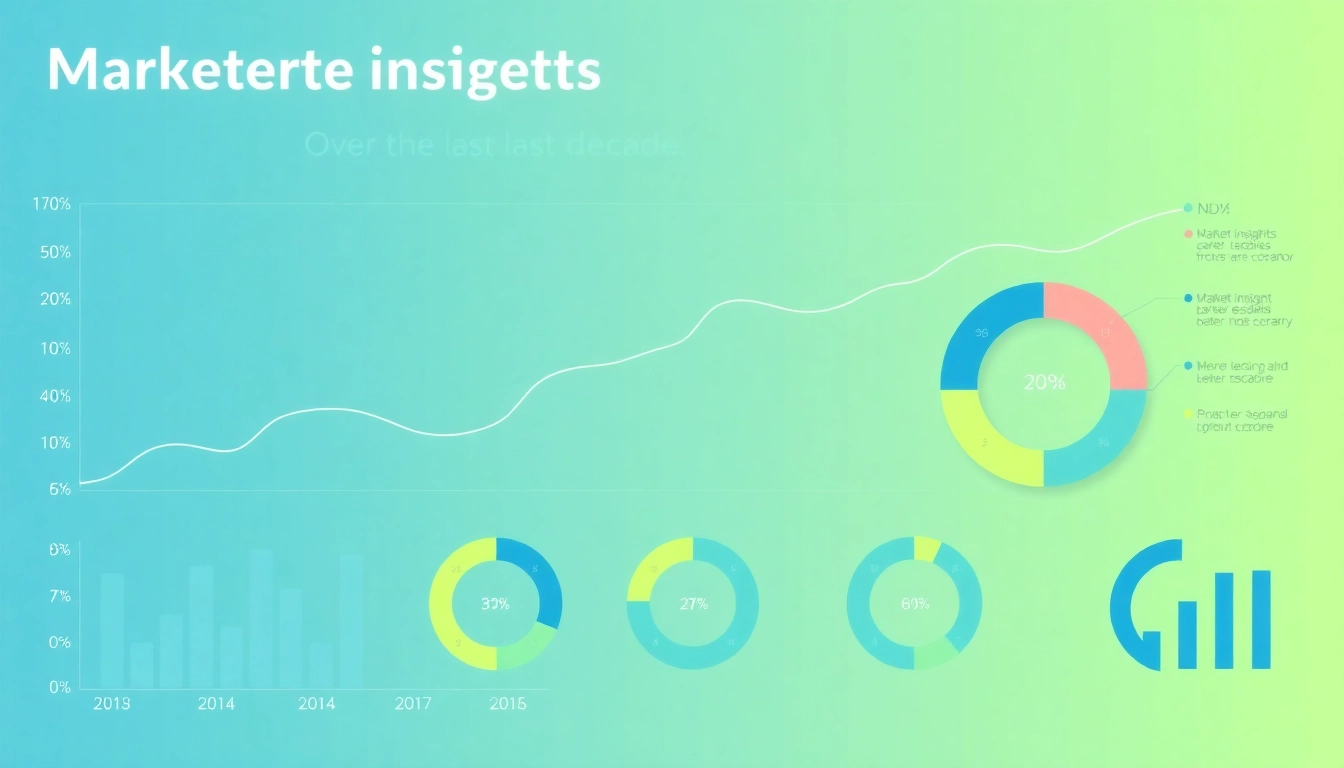The Ultimate Guide to Market Insights for Smart Decision Making

Understanding Market Insights
Defining Market Insights and Their Importance
Market insights are critical pieces of information obtained through a comprehensive investigation of a market’s dynamics, behaviors, and trends. They enable businesses to understand consumer needs, competition, and overall market landscape better. By integrating these insights into their decision-making processes, companies can make informed strategies that foster growth and expand market share. As noted by various experts, these insights serve as the backbone of successful marketing campaigns and product development initiatives.
Having a robust framework for gathering and analyzing market insights empowers firms to navigate the complexities of the business environment with greater confidence. It assists them in anticipating changes in consumer behavior, economic shifts, and industry trends, ultimately leading to smarter business decisions.
How Market Insights Drive Business Growth
Utilizing market insights effectively can catalyze significant business growth. When businesses leverage these insights, they can:
- Identify New Opportunities: Recognizing emerging market trends can unveil new customer segments or product lines.
- Enhance Customer Satisfaction: Understanding customer preferences enables companies to tailor their products and services more closely to consumer desires.
- Refine Marketing Strategies: Market insights allow for more precise targeting and positioning, ensuring marketing efforts resonate with the intended audience.
- Minimize Risks: By analyzing market dynamics, businesses can make proactive decisions, mitigating potential risks associated with market fluctuations.
In summary, market insights are indispensable tools that, when utilized properly, can significantly stimulate company growth by aligning business strategies with market realities.
Common Misconceptions About Market Insights
Despite their importance, several misconceptions persist about market insights. Understanding these can clarify their role and potential benefits:
- Market Insights are Only Data: Many believe that market insights are synonymous with data. While data is integral, true insights arise from interpreting that data within the context of market behavior and trends.
- Only Large Businesses Benefit: Small and medium-sized enterprises can also leverage market insights to enhance their competitiveness. Tailored strategies based on insights can yield substantial growth opportunities.
- Insights are One-Time Investments: Effective market insights require ongoing collection and analysis. Markets are dynamic, and continuous engagement is essential to maintain relevance.
Types of Market Insights
Quantitative vs. Qualitative Market Insights
Market insights can be broadly categorized into two types: quantitative and qualitative. Both types offer unique benefits and play distinct roles in strategic decision-making.
Quantitative Market Insights
Quantitative insights involve numerical data and statistical analysis. This type of insight is typically obtained through surveys, transaction data, or market analytics tools and can highlight trends, patterns, and correlations through measurable parameters. For instance, a company might analyze sales data trends to determine the impact of seasonal purchasing behaviors on their product lines.
Qualitative Market Insights
Qualitative insights, on the other hand, delve into the reasons behind consumer behaviors and preferences. Methods like interviews, focus groups, and observational research are utilized to gather this information. For example, through focus groups, a business might learn that consumers are concerned about sustainability when making purchasing decisions, offering valuable context to inform product development strategies.
Industry-Specific Market Insights
While some market insights apply across various sectors, industry-specific insights provide targeted analysis tailored to particular market characteristics. For example, the technology sector may focus on user adoption rates and technology trends, while the retail sector might concentrate on consumer purchasing behavior and seasonal trends.
Acquiring these insights often involves analyzing industry reports, market research studies, and data analytics tailored to specific sectors. This nuanced understanding allows businesses to tailor their products and marketing messages more effectively.
Customer Centric Market Insights
Customer-centric insights prioritize understanding the consumer at every level. It involves creating a detailed customer profile that includes demographics, purchasing behaviors, preferences, and feedback. Building this comprehensive picture allows businesses to craft personalized experiences that resonate with their audience.
Techniques such as customer personas, journey mapping, and ongoing engagement through feedback mechanisms are critical in gathering customer-centric insights. By focusing on customers’ positions, businesses can develop products and services that deeply connect with their target audience and enhance customer loyalty.
Collecting Market Insights Effectively
Tools and Techniques for Data Collection
The success of any market insights strategy hinges on effective data collection. Using various tools and techniques ensures a comprehensive understanding of market dynamics:
- Surveys and Questionnaires: One of the most direct methods for gathering customer data. Online platforms such as SurveyMonkey or Google Forms facilitate wide distribution and easy analysis.
- Social Media Analytics: Platforms like Facebook, Instagram, and Twitter offer insights into customer engagement and sentiment, allowing businesses to capture real-time consumer behaviors.
- CRM Systems: Customer Relationship Management systems consolidate customer data, providing analytics that reveals purchasing trends and customer preferences.
Implementing Surveys and Focus Groups
Surveys and focus groups are both effective approaches for gathering qualitative and quantitative insights. When implementing these methods, businesses should:
- Define clear objectives: Understand what information you want to gather and how it aligns with your business goals.
- Ensure diverse representation: Including a wide range of demographics in surveys and focus groups can provide a more accurate reflection of market sentiments.
- Analyze results methodically: Collect and categorize feedback to draw actionable conclusions and insights promptly.
Analyzing Market Insight Data
Once data is collected, the next critical step is analysis. The process often involves statistical analysis for quantitative data and thematic analysis for qualitative insights. Effective data analysis allows businesses to:
- Identify trends and anomalies within the data.
- Develop actionable marketing strategies based on concrete evidence.
- Acknowledge areas needing improvement and innovation.
Employing software tools like Excel, SPSS, or Tableau can streamline the analysis process and make it manageable.
Applying Market Insights to Business Strategy
Integrating Insights into Business Planning
Market insights should directly influence business planning. Integrating these insights requires a systematic approach:
- Operational Alignment: Business plans must incorporate insights to ensure operational strategies reflect market realities.
- Cross-Departmental Communication: Insights should reach all relevant stakeholders to foster cohesive strategies.
- Regular Updates: Market dynamics shift, so plans must be adaptable, allowing for ongoing integration of fresh insights.
Using Insights for Product Development
Insights are essential in steering product development, from conceptualization to feature enhancement:
- Identifying customer needs and pain points can guide new product features or entirely new product lines.
- Testing prototypes with target users and using their feedback can refine the product before market introduction.
- Post-launch, continue to seek customer feedback and market data to iterate on product offerings.
Marketing Strategies Driven by Market Insights
Effective marketing strategies rely heavily on understanding the market landscape:
- Targeted Campaigns: Utilizing insights allows for precise audience targeting, increasing the effectiveness of marketing campaigns.
- Brand positioning: Understanding market perceptions helps in crafting messaging that resonates with consumer values.
- Channel Optimization: Insights guide businesses in choosing the right channels for communication based on where their audience is most active.
Measuring the Impact of Market Insights
Key Performance Indicators (KPIs) to Track
To determine the effectiveness of leveraging market insights, businesses should track relevant KPIs, such as:
- Customer Satisfaction Scores (CSAT): Indicates how well products and services meet customer expectations.
- Net Promoter Score (NPS): Gauges customer loyalty and likelihood to recommend your product.
- Sales Growth Rate: Monitors increases in sales attributed to insights-driven strategies.
Feedback Loops for Continuous Improvement
Establishing feedback loops is critical for a business to adapt and refine its strategies based on market insights. This can be achieved through:
- Regularly reviewing and analyzing customer feedback.
- Implementing agile methodologies that allow for quick pivots based on emerging insights.
- Cultivating an organizational culture that actively seeks and adapts to new information.
Case Studies of Successful Market Insights Implementation
Real-world applications of market insights underscore their value. For example:
- Starbucks: By analyzing consumer preferences and behaviors, Starbucks has been able to tailor its menu offerings and store designs to better resonate with customers, driving increased sales.
- Amazon: Through continuous analysis of purchasing behavior, Amazon has refined its recommendation algorithms, leading to enhanced customer experiences and increased sales.
- Coca-Cola: Their “Taste the Feeling” campaign was guided by insights into global consumer trends, emphasizing emotional connections that align with diverse consumer experiences.









